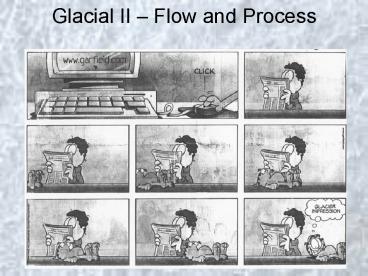Glacial II Flow and Process PowerPoint PPT Presentation
1 / 29
Title: Glacial II Flow and Process
1
Glacial II Flow and Process
2
Specific Mass Budget
- Point mass budgets measured with ablation stakes
- End of summer to EOS
- Uses old snow/firn/ice as a marker
3
Specific Mass Budget trends
- Accumulation often increases slightly with
increasing altitude. - _at_ ELA, bn 0
- Ablation increases rapidly with decreasing
altitude below the ELA. - Why?
EQUILIBRIUM LINE ALTITUDE
4
Snowlines
- Indicator of mass balance
- Short-term
- Firn line
- Highest firn line
- Long-term
- ELA
5
Snowlines
- Glaciation Threshold
- Cirque floors
- Highest lateral moraines
- Toe-headwall altitude ratio
- Accumulationarea ratio
6
Controls on Snowlines I - Latitude
- Latitude temperature (treeline)
- Highest near equator
- Latitude ? precipitation (snowlines)
- Saddle near equator
- Weak gradients (lt1 m/km)
7
Controls II - Continentality
- Lowest near moisture source
- Higher inland
- Strong gradients
- Up to 10 m/km
8
Spatial Resolution
- Humlum (1985)
- West Greenland
- Local data are consistent
- Needs no smoothing
- High resolution!
9
MT/ID Paleoclimate
- Complex pattern!
- More detailed than modern weather stations and
SNOWTEL sites! - Explain?
10
Observed Flow Plan and Profile
- Plan View
- Parabolic
- Septum (ice streams)
- Profile
- Exponential
- Non-zero at the bed
- t ?ghsin(a)
11
Modes of Profile Flow
- Total Velocity
- Internal Velocity
- Laminar
- Sum of processes
- Basal Slip
- Not if frozen to bed
- Bed Deformation
- If not rock
12
Observed Bed Deformation
- Inferred from structures in till
- Measured from markers emplaced in basal sediment
and recovered
13
Brittle Deformation - Crevasses
- Long observed
- Results from rapidly-applied stress
- Form many distinctive patterns
14
Crevasse Examples
- Depth lt10m
- Tensional and marginal
- Terminal splays
- Complex systems
15
Unsteady Flow - Surges
- Many glaciers (10) surge
- Stagnant for years
- Increase in thickness
- Surge!
- Decouple from the bed?
- Surface fracturing
- Thrusting?
16
Surging Terminus
17
Summary of Flow Process I
18
Summary of Flow Process II
t1 bar
19
Glacier Bed Processes
- Most important processes happen out of sight
- Deformation (internal, bed)
- Erosion
- Deposition
- Processes are a function of
- Thermal regime
- Behavior of ice
- Behavior of bed material
20
Observed Ice Core Temps
- Greenland
- Shallow warm bulge
- Tbed lt 0C
- Antarctica
- Shallow warm bulge
- Tbed 0C
- Reflects temperature change with time
- LIA, Hypsithermal
21
Thermal Regime
- Critical to processes!
- Warm wet-based
- Cold dry-based
- ?ice lt ?water, therefore
- Pressure increase forces melting point decrease
PMP - -0.7C/km of ice
- Because PMP lt 0C, heat is trapped at the bed of
warm ice - Warm ice thick, fast, temperate or heated
Pressure Melting Point
22
Pressure Melting
melt
melt
- For ice at PMP
- Movement increases pressure, thus melting, on the
up-ice side of an obstruction - Movement away from the obstruction causes
freezing on the down-ice side regelation
23
Effects of Pressure Melting
- High pressure is experienced on the upice side of
an obstruction. - Pressure melt results
- Water migrates around/through obstacle
- Regelation occurs in low pressure zone
MELT
REFREEZE
24
Erosion by Plucking
- Regelation incorporates loose bed material into
basal ice plucking
25
Abrasion
- Plucked material is available to wear away the
bed abrasion
26
Abrasion Features / chattermarks
27
Polish
- Typical of similar hardness (bed vs. tool) and
fine load ( sandpaper)
28
Erosion and Deposition
- Erosion
- Plucking vs. abrasion
- Effect of pressure
- Effect of velocity
- Deposition
- Lodgment vs. meltout
29
The Subglacial System
- f(distance) downice
- Water increases to the terminus
- Debris decreases below the terminus

